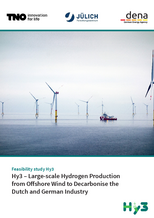
Berlin, 30 March 2022. The Deutsche Energie-Agentur (dena) – the German Energy Agency – together with the German Jülich Research Centre (Forschungszentrum Jülich) and the Netherlands Organisation for Applied Scientific Research (Nederlandse Organisatie voor Toegepast Natuurwetenschappelijk Onderzoek, TNO), investigated what a transnational hydrogen economy could look like in the year 2050 as part of the Hy3 study. The final report shows the feasibility of transnational green hydrogen value chains – from the North Sea to the industrial clusters of the Netherlands to North Rhine-Westphalia, Germany. According to the study, transnational cooperation in the development of a common hydrogen market and the construction of hydrogen infrastructures can strengthen the regions concerned in their endeavour to decarbonise their economic clusters.
Andreas Kuhlmann, Chief Executive of the German Energy Agency, notes, ‘The development of hydrogen value chains can and must be considered and approached on a pan-European scale. The joint use of production and import capacities, as well as infrastructures within the framework of transnational cooperation, creates synergies and strengthens the ability of strong industrial regions in the heart of Europe to protect the climate and maintain the security of supply.’
René Peters, Business Director Gas Technology at TNO, adds, ‘The HY3 study shows the value of building an integrated hydrogen transport infrastructure based on the existing gas infrastructure and storage options in salt caverns between the Netherlands and NRW. The Netherlands and Germany can accelerate the utilisation of hydrogen on a large scale by taking on the mutually shared challenge to develop an interconnected hydrogen transport and storage infrastructure.’
Industry and mobility are promising sectors for green hydrogen
Another result of the study is how promising it is to use green hydrogen for the purposes of industry and mobility. The petrochemical industries in North Rhine-Westphalia and the Netherlands currently have a combined hydrogen demand of 58 terawatt hours (TWh) per year. By 2050, the total demand in the two sectors has the potential to increase sevenfold, reaching up to 401 TWh.
Green hydrogen – paths for growth
Green hydrogen can be produced by electrolysing desalinated seawater using renewable electricity from offshore wind turbines in the North Sea. The results of the Hy3 study imply that the annual yield of hydrogen production using offshore wind energy could reach 54–139 TWh in the Netherlands and 37–100 TWh in Germany by 2050. Additional supply sources are needed as well in order to meet the hydrogen demand in the Netherlands and North Rhine-Westphalia. Maritime imports are of particular importance in this context.
Integrated infrastructures for transport and storage
Both the Dutch and German gas transmission system operators have published their visions for a hydrogen backbone. These plans, which include more than 5,000 kilometres of converted natural gas pipelines, were used as a starting point for analysing the transnational hydrogen infrastructure. The study found that the partial repurposing of natural gas pipelines for hydrogen transport in the Netherlands and Germany, which is set to be completed by 2030, will create sufficient transport capacities for supplying industrial demand. Developing hydrogen storage systems in existing and new salt caverns in the neighbouring countries will be a useful and necessary factor in providing balance to a more flexible energy system.
The Hy3 study – recommendations for action
The study suggests promoting German-Dutch initiatives to create a common market with a future-proof vision as a concrete recommendation for action. To do this, administrative barriers must be removed, and transnational cooperation in the industrial transformation must be accelerated. In a binational and European context, both the creation of joint initiatives for research, development and innovation and the development of demonstration projects that address overall benefits at the system level (such as in the IPCEI programme) play an equally important role.
For more information on the Hy3 project and the results of the feasibility study, please visit: https://hy3.eu
About the Hy3 project
The Hy3 project investigated different facets of the hydrogen value chains in order to link production on the Dutch and German North Sea with demand centres in both the Netherlands and Germany. The project focuses on North Rhine-Westphalia and Dutch industrial centres. The project is being implemented by dena and its project partners, the German Jülich Research Centre and the Netherlands Organisation for Applied Scientific Research (TNO), in cooperation with the German Federal Ministry of Economics and Climate Protection (Bundesministerium für Wirtschaft und Klimaschutz, BMWK), the Ministry of Economic Affairs, Innovation, Digitalisation and Energy of the State of North Rhine-Westphalia (Ministerium für Wirtschaft, Innovation, Digitalisierung und Energie des Landes Nordrhein-Westfalen, MWIDE) and the Netherlands Ministry of Economic Affairs and Climate (Ministerie van Economische Zaken en Klimaat).
Picture: GettyImages/Charlie Chesvick/E+
